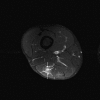Recurrent hamstring muscle injury: applying the limited evidence in the professional football setting with a seven-point programme
- PMID: 23322894
- PMCID: PMC4033203
- DOI: 10.1136/bjsports-2012-091400
Recurrent hamstring muscle injury: applying the limited evidence in the professional football setting with a seven-point programme
Abstract
Recurrent hamstring injuries are a major problem in sports such as football. The aim of this paper was to use a clinical example to describe a treatment strategy for the management of recurrent hamstring injuries and examine the evidence for each intervention. A professional footballer sustained five hamstring injuries in a relatively short period of time. The injury was managed successfully with a seven-point programme-biomechanical assessment and correction, neurodynamics, core stability, eccentric strengthening, an overload running programme, injection therapies and stretching/relaxation. The evidence for each of these treatment options is reviewed. It is impossible to be definite about which aspects of the programme contributed to a successful outcome. Only limited evidence is available in most cases; therefore, decisions regarding the use of different treatment modalities must be made by using a combination of clinical experience and research evidence.
Keywords: Exercise Rehabilitation; Hamstring Injuries; Muscle Damage/Injuries; Soccer; Soft Tissue Injuries.
Figures




References
-
- Alonso JM, Tscholl PM, Engebretsen L, et al. Occurrence of injuries and illnesses during the 2009 IAAF World Athletics Championships. Br J Sports Med 2010;44:1100–5 - PubMed
-
- Orchard JW, James T, Portus MR. Injuries to elite male cricketers in Australia over a 10-year period. J Sci Med Sport 2006;9:459–67 - PubMed
-
- Arnason A, Sigurdsson SB, Gudmundsson A, et al. Risk factors for injuries in football. Am J Sports Med 2004;32(1 Suppl):5S–16S - PubMed
-
- Brooks JH, Fuller CW, Kemp SP, et al. Incidence, risk, and prevention of hamstring muscle injuries in professional rugby union. Am J Sports Med 2006;34:1297–306 - PubMed
-
- Ekstrand J, Hagglund M, Walden M. Injury incidence and injury patterns in professional football: the UEFA injury study. Br J Sports Med 2011;45:553–8 - PubMed
Publication types
MeSH terms
LinkOut - more resources
Full Text Sources
Other Literature Sources
